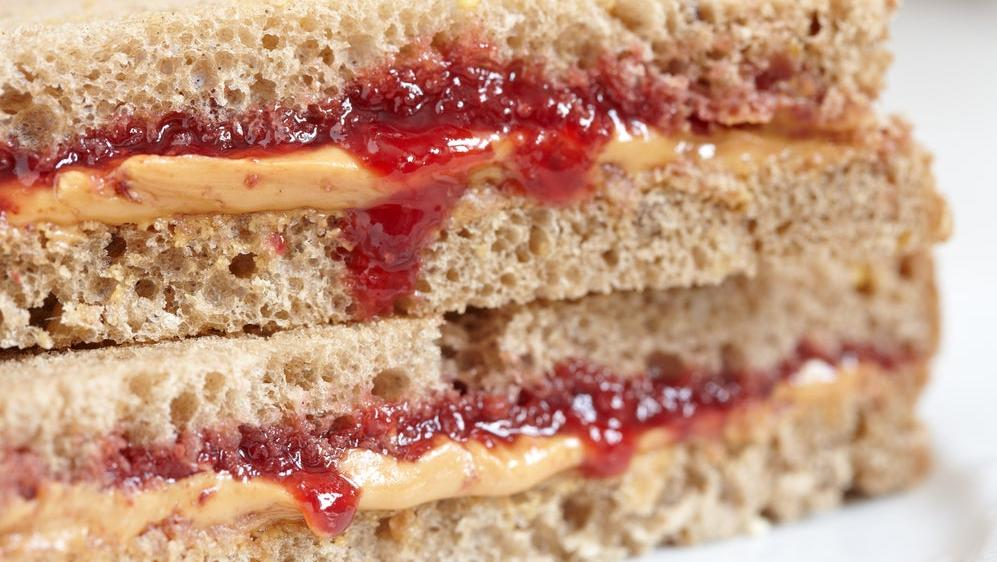What Makes Peanut Butter Uniquely American
Peanut butter has been part of American history in more ways than one.
In any discussion of the most "American" foods, images of apple pie, hot dogs, and burgers likely dance around in your mind. But what about peanut butter? The versatile spread is a staple of our sandwiches, desserts, smoothies, and even our stir fry dishes. In fact, peanut butter is so ubiquitous in the American diet that you might not know we have way more fondness for the stuff than most of the world does—and the reason for its success here in the States involves both hydrogenation and a dash of nostalgia.
A quick history of peanut butter
Although the Inca civilization of Peru can be credited as the first population to grind peanuts into paste, which they did many hundreds of years before any North Americans did, John Harvey Kellogg—yes, that problematic cereal figure—was the first to officially patent an early version of nut butter in 1895, Smithsonian Magazine explains.
During World War I, the American public turned to protein-packed peanut spread as an alternative to meat during wartime rationing. Then, in 1920, Peter Pan (originally known as E.K. Pond) became the first brand to commercially develop the product as we know it today.
CNBC explains that Joseph Rosefield, the creator of Skippy, had previously secured a patent for hydrogenation—a process that prevents the oil from separating in a jar of peanut butter—but he wouldn't actually start his Skippy business until 1932. Until then, it was the Peter Pan brand that first put Rosefield's patent to use, and hydrogenation expanded the shipping abilities of peanut butter, allowing businesses to scale up operations. Both Skippy and Jif followed suit in later decades.
The commercial production of sliced bread also came about in the late 1920s, further cementing peanut butter's place in American culture and bringing about the classic school kid lunch: the PB&J. By World War II, tins of Skippy were shipped with service members overseas, and meat rationing once again led the American public back to peanut butter. Nostalgia has played an important role in keeping peanut butter in our pantries ever since.
How the rest of the world views peanut butter
Other countries just don't have the same love for this spread that we do. In Russia, for example, peanut butter has been historically unavailable, and Screen Rant explains that largely continues to be the case. In the most recent season of Stranger Things, a Russian character named Yuri smuggles peanut butter and other goods because those items are banned during the Cold War (when the show takes place). Though it's untrue that peanut butter was outright banned in Russia during this time, it makes sense that the product wasn't available, especially varieties like Skippy and Jif, due to tensions with the United States.
A large part of why peanut butter has a special place in Americans' hearts is because it's what they grew up eating, likely fed PB&J by parents who ate it themselves as kids—and that's exactly why other countries don't have the same love for it. Because large-scale hydrogenation and shipping operations didn't push peanut butter into the hands of other nations' consumers throughout the 20th century as they did in the U.S., the product hasn't seen as much uptake among those consumers since.
Our unique love of peanut butter has consequently caused it to be seen as a uniquely American indulgence. This Vice article from 2014 notes that its global reputation is basically that it's too strong in flavor, too salty and overpowering. However, those perceptions might be starting to change.
A 2020 article from the National Peanut Board—so take this with a huge grain of salt—notes peanut butter's popularity has risen in the United Kingdom in recent years. Some of the reasons noted are the general rising global interest in plant-based products and the onset of the COVID-19 pandemic, which, much like the meat rationing during wartime, led to people searching for filling foods that would last a long time.
America’s ongoing love of peanut butter
Today, peanut butter is a $2 billion industry, according to research firm Circana. CNBC also cites consumer research indicating that "Peanut butter holds a 90% household penetration rate, comparable to other grocery staples such as breakfast cereal, granola bars, soup and sandwich bread."
Even an area of concern for the industry, peanut allergies, hasn't done much to curb enthusiasm for the product. Though nut allergies might pose a challenge in terms of younger generations incorporating peanut butter into their diets (and eventually, their grocery budgets), the world's largest brands are finding ways around it.
"It's become more of an issue in the last 10 years or so, but the categories continue to grow even as the prevalence of allergy or the reporting of the prevalence of allergy has picked up," Matt Smith, VP of Equity Research at Stifel Financial Corp, told CNBC. "So while it's a threat, it's certainly not impacting sales."
From wartime sustenance to school lunch staple, peanut butter has shown it has major sticking power. Now that you know a bit more about its global reputation, why not make sure you're buying the best brand?
